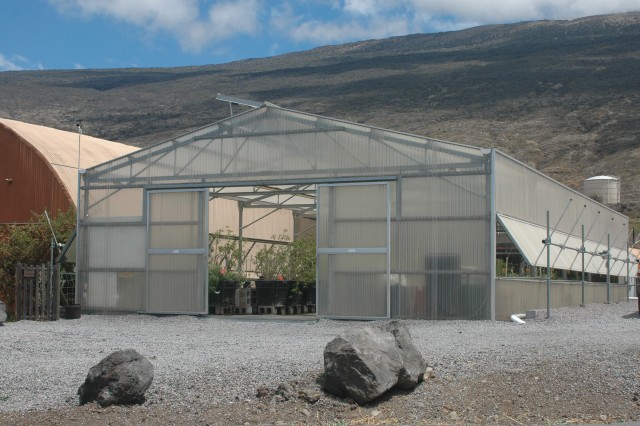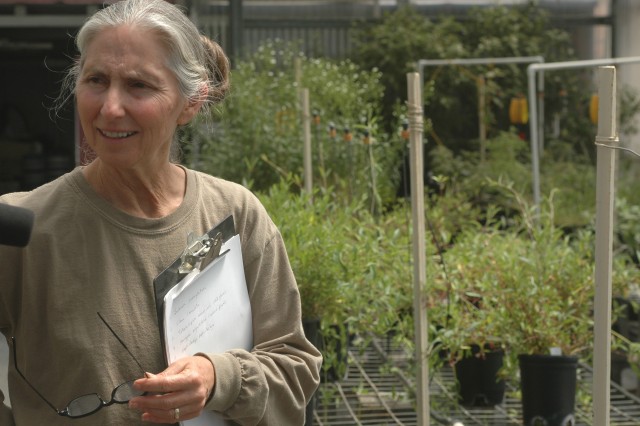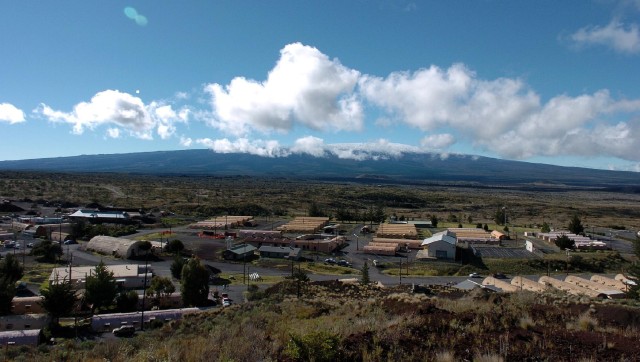POHAKULOA TRAINING AREA, Hawaii - The Army is waging a war, here.
However, this particular combative engagement is not the kind that pits a Soldier against an opposing force or even a Soldier against machine.
The battle being fought at the Pohakuloa Training Area is nature against nature.
Located on the saddle between the Mauna Loa and Mauna Kea volcanoes, the 132,000 acres or 210 square miles that make up the military's training area at PTA is home to one of the world's rarest ecosystems: a tropical, sub-alpine, dryland ecosystem.
Nineteen endangered species, 15 of which are plants, grow and live, here. Threats of fire and invasive plant and animal species are ongoing, a battle of nature against nature.
Providing the "weapons" to fight this battle is PTA's Natural Resources Office. Weapons include knowledge, mechanical tools and some good old-fashioned weed-pulling with one objective in mind: preserve and protect PTA's three designated bird and plant critical habitats consisting of 12,000 acres.
Falling under the Environmental Division, Directorate of Public Works, U.S. Army Garrison-Pohakuloa, the office manages PTA's Natural Resource Program.
Dr. Peter Peshut, biologist, is program manager. He and the program's 50 technicians and laborers identify, manage and protect PTA's federally listed species.
Fire is the major threat to plants and animals, Peshut said.
"Pohakuloa is so dry," he said. "We get five to 15 inches of rain a year. Plus, the soils here are very, very thin. It's also windy, here, so fire can be devastating."
To meet the fire threat, staff controls alien grasses and alien plants by mechanical means or by pulling. The staff also builds firebreaks, which are cleared strips of land to stop the spread of a fire.
"If a fire comes from off-site PTA, we can stop it before it gets here," Peshut said. "If one starts on PTA, we can contain it before it wipes out our native Hawaiian plant populations."
Another threat is from feral animals, animals that were once domesticated.
Peshut said that major threats at PTA are goats, sheep and pigs. He said that goats and sheep browse directly on the native forests, as well as on the federally protected plants, all of which haven't adapted to the browsing (grazing) pressure.
"The pigs root for food, and they tend to disturb habitat. They dig up the soil, they eliminate new seedlings, they often keep the land in a perpetual state of being torn up," Peshut said.
"The native plants can't get a grip to hold and to grow," he added. "The pigs aren't looking to eat the native plants, but they destroy the habitat, so plants don't have a chance to propagate and grow."
There are other challenges, too.
"The land area is shrinking. The Army needs more land to train on, but there is only a finite amount of land and so there are some colliding priorities," he said. "A good example of that is the federally protected Hawaiian Nene goose, which occupies a good part of our ranges for a good part of the year.
Peshut also oversees a program that propagates or grows seedlings in a greenhouse that are later used for out-planting.
"Pohakuloa has some lands that haven't been used much, and we are the last place for some of these species," Peshut said.
"The populations are low," he added. "Some of our species are not found anywhere else in the world; the numbers can range anywhere from 75 to 100 left. Low numbers are actually a threat. We manage that threat by propagating the plants ... so they can grow on their own."
Victory does come out of this battle with nature. A significant portion of large-scale fence units have been erected around the protected areas. Browsing animals have been cleared from those units.
"Indications are that the flora and fauna are improving after removing that introduced threat," Peshut said. "Our out-planting efforts are generally successful; we have genetic material stored in a seed bank for later out-planting. Plus, we have a nice network of firebreaks."






Social Sharing